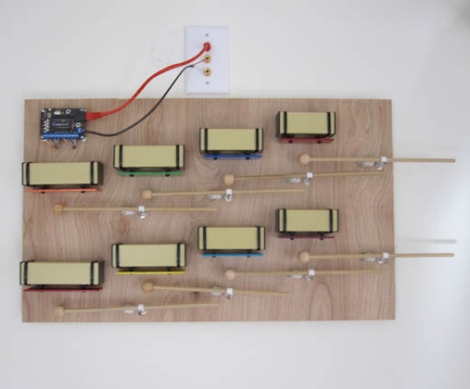
When [David] moved into his new house, one of the things he noticed was that his doorbell was pretty lame. Coming from a home equipped with a solenoid and chime bell, his new wireless solid state doorbell sounded terrible to him.
Crummy sound aside, the doorbell hardly ever worked properly, but alas, other projects cropped up and years went by before [David] addressed his doorbell problem. Like many things that take a long time to come to fruition, we think his resonator bell based solution was well worth the wait.
One of his main goals was to make a nice sounding doorbell that also looked great. He mounted a kid’s resonator bell toy on a sheet of wood, creating his own wooden mallets for the job. He initially had a tough time locating actuators for his doorbell, but found a solution in geared pager motors as featured in another xylophone hack on Make. With the hardware taken care of he focused on the electronics, which consist of a pair of Arduino clones – one on the display and one in his basement.
Stick around to see [David’s] Campanello doorbell in action, and be sure to check out his site for more details if this sounds like something you would like to have in your home.
[via Make]
[vimeo http://vimeo.com/23187397 w=470]














that’s pretty cool!
Great project :D
Lovely design and sound. Also, it’s got a very elegant name :)
I can see those plastic pins snapping off at some point on the part that moves the stick, Better if it was reinforced .
Here’s a bit of weird, side information.
I had two dogs since I’ve had this house. They grew up in this house, and the door bell NEVER worked. So, (remember this, it’s important), they NEVER heard a door bell before, and have NO reason to associate people at the door, with a doorbell.
One day while listening to a movie, somebody (in the movie) rang the doorbell. The dogs went nuts, running to the door.
Why? How? It’s just one of those inherent sounds that dogs just “know” about or something. Like the “crinkle” of a potato chip bag or squeaky toy….
Carry on….
Weird indeed, and I’ve heard and seen other such incidents where dogs knew stuff that does not seem to occur in nature and they were never taught but which seems a born-in adaption to humans, but a doorbell is something that isn’t that ancient so it’s extra weird.
But science is accepting of ‘genetic memory’ these days at least, although I’m not sure they exactly know all the mechanisms involved (and that’s probably for the best else some would abuse it :/)
At my local homeimprovement place they used to sell a selection of doorbells and some of the fancy ones had metal tubes that were struck, then over time those were phased out and now it’s all electronic.
However there are chips that are designed to give a very real bell sound, but even if they do you need a good speaker, and the whole assembly would end up costing more and needing more hardware than a simple tube that is hit, it’s a bit ironic that attempting to ‘simplify’ and ‘make cheaper’ achieves less at an equal or greater cost.
DAMMIT again hacked by the ‘keep the reply status maintained after a reply’ thing on hackaday, I need to get a script or something to fix that.
@ Microguy:
While they may not have had the sound of your doorbell condition them, if you live within 100 feet or so of the next house your dogs will have listened to your neighbor’s bell(s) quite a bit.
Cool! Great write up!
Best part is:
“I designed a simple hinge in OpenSCAD and had it printed by Shapeways. For about $25 I got 10 copies of a simple hinge made that worked exactly the way I wanted (shipped from the Netherlands, no less).”
I think more people need to know this is possible without a $1300 Makerbot Thing-O-Matic.
Super cool! But can it do the Jetson’s doorbell ring?
how do you have a solid state device that generates pressure waves?
Simple layout, masterfully executed. The design is so elegant that the finish masks the complexity very well.
This would be a great piece of art if you added some more octaves and made sure all of the hinges were tidy and the whole thing more colour co-ordinated. Fantastic project and very neato!
Awesome project!
I noticed on the github page where you post the source and schematics, there are several different files to view…
1) .pcb, .project and .sch files
2) .brd and .sch files
3) .scad files
What software would you recommend to view these files?
Glad you liked the project!
1. The main controller files (.pcb, .project, .sch) were generated using the gEDA suite of tools, particularly pcb and gschem.
2. The downstairs breakout files (.brd and .sch) were generated using CadSoft Eagle.
3. The hinge (.scad) was built using OpenSCAD.